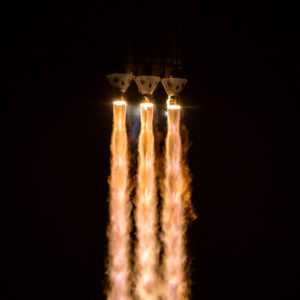After multiple delays, eventually resulting in a scrub for the original planned August 11th launch date, the Parker Solar Probe successfully began its mission mission to “touch the Sun” this morning at 3:31 AM .
Yeah, quite early, but early enough that I could easily just stay awake to watch it, and I’m glad I did. It was a hell of a show, with quite the intense moment near the end.
Weather originally looked a little spotty, but by launch time it was judged 95% good for launch. The booster had been checked since the scrub the previous morning and seemed good. The pre-launch hold came and went with no issues, and polling was go for launch. Everything was looking perfect. The final countdown began, the 3 RS-68 engines of the Delta IV Heavy’s 3 Common Core Boosters ignited, and in a typical show of fire and fury native only to the Delta IV (the burning of excess hydrogen vapor coming from the engines during their pre-ignition phase) the booster lifted off from Space Launch Complex 37, beginning what is normally the most tense part of any mission – the launch phase.
We’re signing off from the #ParkerSolarProbe launch! To follow @NASA’s launch to explore the inner workings of our nearest star, be sure to bookmark https://t.co/txkAmzA1kk pic.twitter.com/VogrR1TaI8
— NASA Social (@NASASocial) August 12, 2018
Delta IV performed nominally. Apparently there were minor issues, but nothing that caused any problem to the launch. The boosters separated as planned, and the core stage continued onward before it too was expended and jettisoned.

The United Launch Alliance Delta IV Heavy rocket launches NASA’s Parker Solar Probe to touch the Sun, Sunday, Aug. 12, 2018 from Launch Complex 37 at Cape Canaveral Air Force Station, Florida. Parker Solar Probe is humanity’s first-ever mission into a part of the Sun’s atmosphere called the corona. Here it will directly explore solar processes that are key to understanding and forecasting space weather events that can impact life on Earth. Photo Credit: (NASA/Bill Ingalls)
The Delta Cryogenic Second Stage took over, inserting the solar probe into Earth orbit. After a 13 minute coast phase, the DCSS ignited again to burn for 14 minutes. This put Parker Solar Probe on an escape trajectory from Earth orbit, but this still wasn’t enough.
This is where the a variant of the STAR-48 solid motor upper stage took over. Unique to this Delta IV Heavy launch, this motor would provide that final kick to get the Parker Solar Probe on the correct trajectory for its rendezvous with Venus and the Sun. This is also where things got scary.
Waiting for Third stage burnout confirmation, telemetry is spotty. #ParkerSolarProbe
— NASA's Launch Services Program (@NASA_LSP) August 12, 2018
As soon as the stage ignited, telemetry data became spotty. Occasionally information would come in, but it was pretty incomplete. Still, it was some kind of data, but this is the point where I started to panic. Seriously, I was really worried things had gone horribly wrong. It was probably the single most tense moment I’ve ever had in watching a launch!
The 3rd stage burn was supposed to be for a relatively short time that came and went without verification of spacecraft separation. We then got word that older data was being sent from the 3rd stage – telem Time seemed to stand still while this happened, but after a moment I noticed applause from the mission staff being shown on the livestream at that moment, and just seconds later confirmation was given that Parker Solar Probe was on its way safely.
We have spacecraft separation! #ParkerSolarProbe pic.twitter.com/mYuAodXhzN
— NASA's Launch Services Program (@NASA_LSP) August 12, 2018
Those last moments though were quite the panic, but it was all worth it to know Parker Solar Probe is on its way to the Sun! Especially awesome is knowing that my name, along with the names of over a million other people, are stored on an SD card which is stored on the probe – basically, in a symbolic digital way, those of us who have our names on the probe are heading to the Sun!
The #ParkerSolarProbe is on a trajectory that will bring it closer to the Sun than any other object created by humanity. pic.twitter.com/uCjhnooVpC
— NASA's Launch Services Program (@NASA_LSP) August 12, 2018
I’ll write more about the Parker Solar Probe as events happen. I’m looking forward to covering this over the next 7 years of its planned mission! With that being said, below I’ll provide, as usual, some launch footage. Enjoy!
Below is a full copy of the launch livestream. If you jump to 1 hour 7 minutes in, you will be just about to 3rd stage ignition and can follow along in the tense 5 minutes where we didn’t quite know for sure what was happening. In this feed launch happens at about 30 minutes in.
You can see all my Parker Solar Probe articles by following this tag: Parker Solar Probe
